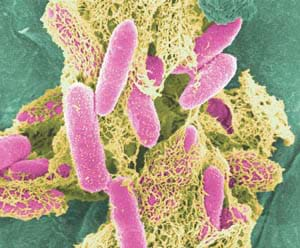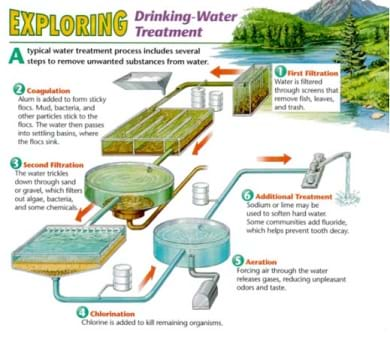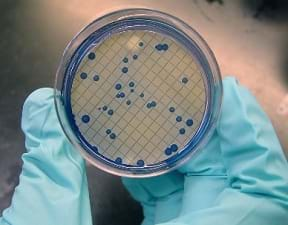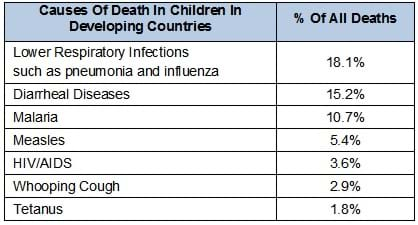Quick Look
Grade Level: 11 (9-12)
Time Required: 30 minutes
Lesson Dependency: None
Subject Areas: Biology, Chemistry, Life Science

Summary
Students learn about water quality testing and basic water treatment processes and technology options. Biological, physical and chemical treatment processes are addressed, as well as physical and biological water quality testing, including testing for bacteria such as E. coli.Engineering Connection
By creating access to clean water, engineers improve human health and save lives around the world. Engineers play a vital role in keeping harmful microscopic organisms out of our water supplies and research is continuously being conducted to develop new ideas to lower the energy demands and costs of treating water. Engineers design large- and small-scale water treatment facilities and water distribution systems that bring clean water to our homes and industries.
Learning Objectives
After this lesson, students should be able to:
- Describe how engineers can test for bacteria in water.
- Describe what turbidity is and how it affects various water treatment options.
- Compare and contrast small-scale water treatment options.
- Explain how water treatment technologies can save lives.
Educational Standards
Each TeachEngineering lesson or activity is correlated to one or more K-12 science,
technology, engineering or math (STEM) educational standards.
All 100,000+ K-12 STEM standards covered in TeachEngineering are collected, maintained and packaged by the Achievement Standards Network (ASN),
a project of D2L (www.achievementstandards.org).
In the ASN, standards are hierarchically structured: first by source; e.g., by state; within source by type; e.g., science or mathematics;
within type by subtype, then by grade, etc.
Each TeachEngineering lesson or activity is correlated to one or more K-12 science, technology, engineering or math (STEM) educational standards.
All 100,000+ K-12 STEM standards covered in TeachEngineering are collected, maintained and packaged by the Achievement Standards Network (ASN), a project of D2L (www.achievementstandards.org).
In the ASN, standards are hierarchically structured: first by source; e.g., by state; within source by type; e.g., science or mathematics; within type by subtype, then by grade, etc.
International Technology and Engineering Educators Association - Technology
-
Assess a technology that minimizes resource use and resulting waste to achieve a goal.
(Grades
9 -
12)
More Details
Do you agree with this alignment?
-
Develop a solution to a technological problem that has the least negative environmental and social impact.
(Grades
9 -
12)
More Details
Do you agree with this alignment?
State Standards
Colorado - Science
-
Develop, communicate, and justify an evidence-based scientific explanation addressing questions regarding the interaction of Earth's surface with water, air, gravity, and biological activity
(Grades
9 -
12)
More Details
Do you agree with this alignment?
-
Analyze and interpret data about the effect of resource consumption and development on resource reserves to draw conclusions about sustainable use
(Grades
9 -
12)
More Details
Do you agree with this alignment?
Worksheets and Attachments
Visit [www.teachengineering.org/lessons/view/cub_waterqtnew_lesson01] to print or download.Introduction/Motivation
Six thousand children die every day from lack of safe water. What can engineers do to decrease this fatality rate and increase health around the world? Engineers design easy-to-use water quality testing procedures, and simple and effective water treatment technologies.
What could possibly be in water to cause so many deaths? The worst threats that hide out in water are pathogens, or harmful microorganisms. Pathogens include disease-causing bacteria, such as E. coli (Escherichia coli), a specific type of coliform bacteria that indicates fecal contamination. Some coliform bacteria are especially harmful; fecal coliforms, for example, that contain harmful bacteria, such as E. coli. Other coliform bacteria are naturally found in the environment and are completely harmless. Some bacteria are even necessary to help us digest our food and keep us healthy. Imagine that! However, unless we know the type of bacteria, their presence in water indicates to us that the water may be unsafe to drink.
Turbidity is another test of water quality. Turbidity is a measure of the cloudiness of the water. Bacteria can feed off of and hide in the organic matter that causes the cloudy and/or dirty appearance of water. Turbidity values also help engineers determine how to treat the water and what type of filtering system would be the most effective. Students can practice water quality analysis through turbidity measurement with the associated activity Save a Life, Clean Some Water!
Once engineers have determined the number of total coliform bacteria and E. coli present in a water sample and the turbidity of that water, they can begin to look at water treatment options. Treatment of a water supply varies, depending on the size of the system (water flow), the resources available, the incoming water quality, and the effluent (outgoing) water quality requirements. Effluent water quality standards are based on the World Health Organization (WHO) for international systems, and the Environmental Protection Agency (EPA) for systems in the United States. No absolute health-based guideline values exist for coliform bacteria or turbidity, but the WHO and the EPA provide recommendations. Coliform bacteria are measured by growing bacteria colonies and counting the colony-forming units (CFU); turbidity is measured in nephelometric turbidity units (NTU), a measure of how well light passes through the water.
Engineers have improved the quality of life in industrialized countries (such as the United States) with the use of chlorine and the design of large-scale drinking water treatment and distribution (piped) systems that make safe water readily available to its populations. We sometimes take it for granted that we have water available inside our homes and feel confident that we will not get sick when we drink it. Engineers continue to research and test ways to improve these systems to increase safety and decrease their costs.
Large municipal water treatment plants use chlorination and sometimes more advanced treatment technologies, such as ozone, membranes or ultraviolet (UV) radiation. A basic chlorination drinking water treatment system consists of six main steps (as illustrated in Figure 2):
- Roughing filter, or settling basin, to remove large particles and debris.
- Coagulation and flocculation to induce opposite charges, which brings molecular-sized bacteria and harmful particles together to form even larger particles, followed by sedimentation to settle the now large groups of particles (flocs) out of the water.
- Secondary filtration to remove bacteria, algae, and any other small flocs still present in the water.
- Chlorination to destroy any remaining bacteria, viruses and pathogens.
- Aeration to remove undesired odors or tastes caused by Steps 1-4.
- Additional treatment, if necessary, such as adding lime (for softening) or fluoride.

Figure 2. Steps in a typical large-scale drinking water treatment plant.
When designing a system to provide drinking water to a large community, engineers consider more than just treating the water. They must find ways to deliver the clean water to every home and keep it clean in the process. A great amount of engineering was needed to design the almost one million miles of pipe that spans our country to bring us clean water! You can see that engineers are integral to cleaning and delivering safe drinking water to our homes and buildings.
You can expect to find at least one—and maybe more—large municipal water treatment plants in every major city. But, for small-scale, rural or developing communities, simpler water treatment systems make more sense. Engineers are continuously designing and implementing new ideas for these systems that improve the health and safety of people around the world, one community at a time. Examples of small-scale treatment methods include:
Today, let's learn a little more about how these water treatment methods work. (Note: with students, please review the attached Water Treatment Fact Sheet for each treatment method.)
Lesson Background and Concepts for Teachers
The World Health Organization (WHO) and the United States Environmental Protection Agency (EPA) set standards for approximately 90 contaminants in drinking water. In this lesson, we focus on two main indicators of water quality: coliform bacteria and turbidity.
Coliform bacteria, a family of bacillus bacteria, are common in the environment and generally not harmful. However, their presence in drinking water is usually a result of a problem with the disinfection process or the water distribution pipes, and indicates that the water may be contaminated with germs that can cause disease. Further, E. coli (a type of fecal coliform) are bacteria whose presence indicates that the water may be contaminated with human or animal waste. Microbes in these wastes can cause diarrhea, cramps, nausea, headaches or other symptoms.
Turbidity has no health effects. However, turbidity can interfere with disinfection and provide a medium for microbial growth. Turbidity may indicate the presence of disease-causing microorganisms. These organisms include bacteria, viruses and parasites that can cause symptoms such as nausea, cramps, diarrhea and associated headaches. Engineers design many types of simpler water treatment systems to use in small-scale, rural or developing communities.
Associated Activities
- Save a Life, Clean Some Water! - Student teams practice water quality analysis through turbidity measurement and coliform bacteria counts.
Lesson Closure
A lot of time, energy and money go into treating the water we use to drink, cook, clean and wash. We are fortunate to have safe water delivered directly to our homes as a result of the efforts of engineers involved in the design of water treatment and water distribution systems. How does this affect our environment and the world? Engineers have helped to reduce the amount of sickness and death that results from contaminated drinking water. The contamination often comes from pathogens or harmful bacteria, such as E.coli. What are two indicators of water quality? (Answer: Testing bacteria present in the water and turbidity)
Large-scale water treatment systems used in big cities include steps for filtering, coagulation and flocculation, sedimentation, chlorination and aeration, as well as (sometimes) lime (for softening) and fluoride. After all these processes, we often do not even realize that our water has been treated, or what is has been through, before it gets to us. Engineers also help design small-scale water treatment methods for remote areas and/or developing countries.
What are some of the small-scale water systems engineers design and install? (Note: Encourage a class discussion based on the treatment ideas discussed.) The development of water treatment technologies by engineers saves lives around the world.
Vocabulary/Definitions
Bacteria: A single-celled microscopic organism (1-5 microns in diameter) that can, in some cases, cause disease.
CFU: Colony Forming Units. A measure of living bacteria cells.
Chlorine Residual: Chlorine atoms are used up as they kill viruses and bacteria in water. The chlorine residual is the amount of chlorine left at a particular point in the system. If no chlorine residual remains by the time water reaches our homes, it is possible for the water to be unsafe and/or easily re-contaminated.
Coagulant: A chemical that brings molecular particles together by introducing opposite charges.
Coliform Bacteria: Any of several bacilli, especially E. coli, found in the large intestine of humans and other animals, the presence of which in water is an indicator of the presence of pathogenic bacteria and viruses.
E. coli: An abbreviation for Escherichia coli, a type of coliform bacteria that can cause serious illness in humans.
Effluent: Water (fluid) coming out of a system after being treated.
Influent: Water (fluid) going into a system (often dirty or unsafe to drink).
Pathogen: A disease-causing organism (e.g., types of bacteria and viruses).
Point-of-Use: As applies to water treatment, a point-of-use system disinfects water right at the location where you collect and use it.
Potable: Fit or suitable for drinking (i.e., is safe to drink).
Turbidity: A measure of the cloudiness or haziness of water (or other fluid) caused by individual particles (suspended solids) that are generally invisible to the naked eye. Measurements of turbidity are used to indicate water quality and filtration effectiveness.
Virus: A microscopic particle (20-300 nm in diameter) that can infect the cells of a living organism.
Assessment
Pre-Lesson Assessment
Discussion Question: Communicable diseases represent seven of the top ten causes of child mortality in developing countries around the world. And, even more shocking, they account for about 60% of all child deaths. (Write the Causes of Death, listed in the left column of the following table, in random order on the classroom board.)
Can you work together as a class to put them in order from what you believe to be the most deadly to the least deadly cause of death? When finished, discuss with students the actual statistics for the percentages of deaths.
Ask the following question: How could we, as engineers, help decrease the second leading cause, diarrheal diseases, and save children's lives around the world? (Answers: Safe drinking water, sanitation and hand washing have been shown to significantly decrease diarrheal diseases.)
Post-Introduction Assessment
Idea Web: Ask students to brainstorm a list of ways that water can be polluted. (Possible answers: From factory chemicals, animal and human waste, pesticides) What effects do these pollutants have on us and our environment? (Possible answers: In the short term, they might make us sick. In the long-term, they can disrupt the balance of ecosystems, kill food sources, and produce long-term illnesses such as cancer.) What are some possible solutions for reducing these types of pollutants? (Possible answers: disposing of chemicals and human waste properly, managing water run off near chemical plants, safe use of pesticides).
Lesson Summary Assessment
Bingo: Provide each student with a sheet of paper to draw a large tic-tac-toe board (a 3 x 3 grid with nine squares) that fills the entire paper. Have students write a lesson vocabulary term in each square, in any order they choose. To mark off squares, have students walk around the room and find other students who can each accurately define one vocabulary term. Students must find a different student for each term. When a student has all terms completed s/he shouts "Bingo!" Continue until two or three students have bingo. Ask the students who shouted "Bingo!" to give definitions of the vocabulary terms.
Homework
Find the Solution: What other simple and low-cost water treatment solutions can you find? Look online for other methods or systems that bring clean, safe drinking water to communities around the world. Keep in mind that resources may be limited in small or rural areas. Ideas for organizations to begin researching: the World Health Organization (WHO), United States Agency for International Development (USAID), and Water for People, to name a few. Students' research will lead to many more organizations. Cite your sources, including at least two more than the three provided.
Lesson Extension Activities
Engineering in Politics / Class Discussion: Solicit, integrate and summarize student responses. Please discuss the following statement from a national report on drinking water distribution systems in the U.S.:
- Of the 34 billion gallons of water produced daily by public water systems in the U.S, approximately 63% is used by residential customers. More than 80% of the water supplied to residences is used for activities other than human consumption, such as sanitary service and landscape irrigation. Nonetheless, distribution systems are designed and operated to provide water of a quality acceptable for human consumption.
Follow up questions:
- Are you willing to pay for municipal water treatment so that all the water we use to flush our toilets and irrigate our yards is safe enough for drinking?
- As an engineer, would you design things differently?
- If you were an advisor to the President, what recommendations or changes would you make about our country's current water system?
- Are we making the best use of our money and resources?
Subscribe
Get the inside scoop on all things TeachEngineering such as new site features, curriculum updates, video releases, and more by signing up for our newsletter!More Curriculum Like This

Student teams practice water quality analysis through turbidity measurement and coliform bacteria counts. They use information about water treatment processes to design prototype small-scale water treatment systems and test the influent (incoming) and effluent (outgoing) water to assess how well the...

Students learn about the various methods developed by environmental engineers for treating drinking water in the United States.
References
National Academies Press. (2006) "Drinking Water Distribution Systems: Assessing and Reducing Risks," Summary, Water Science and Technology Board, 2006, http://www.nap.edu/catalog.php?record_id=11728 (information on public water use)
World Health Organization. (2003) World Heath Report, Chapter 1: Global Health, Today's Challenges.
Copyright
© 2006 by Regents of the University of Colorado.Contributors
Christie Chatterley; Kate Beggs; Malinda Schaefer Zarske; Janet Yowell; Denise W. CarlsonSupporting Program
Integrated Teaching and Learning Program, College of Engineering, University of Colorado BoulderAcknowledgements
The contents of these digital library curricula were developed by the Integrated Teaching and Learning Program under National Science Foundation GK-12 grant no. 0338326. However, these contents do not necessarily represent the policies of the National Science Foundation, and you should not assume endorsement by the federal government.
Last modified: June 30, 2020







User Comments & Tips